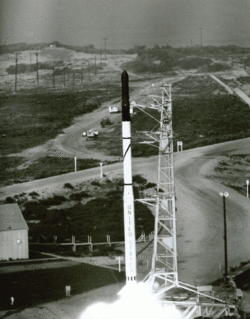Engineering:Scout X-2M
 Scout X-2M with P35-1 payload (DMSP-1, FTV-3501), May 24, 1962 | |
| Function | Expendable launch system |
|---|---|
| Manufacturer | Vought |
| Country of origin | United States |
| Size | |
| Height | 22 metres (72 ft) |
| Diameter | 1.02 metres (3 ft 4 in) |
| Mass | 17,000 kilograms (37,000 lb) |
| Stages | Four |
| Associated rockets | |
| Family | Scout |
| Launch history | |
| Status | Retired |
| Launch sites | Point Arguello LC-D |
| Total launches | 3 |
| Successes | 1 |
| Failures | 2 |
| First flight | 1962-05-24 |
| Last flight | 1963-04-26 |
| First stage – Algol 1D | |
| Engines | 1 solid |
| Thrust | 440 kilonewtons (99,000 lbf) |
| Burn time | 44 seconds |
| Fuel | Solid |
| Second stage – Castor 1A | |
| Engines | 1 solid |
| Thrust | 286 kilonewtons (64,000 lbf) |
| Specific impulse | 247 sec |
| Burn time | 27 seconds |
| Fuel | Solid |
| Third stage – Antares 2A | |
| Engines | 1 X-254 |
| Thrust | 93 kilonewtons (21,000 lbf) |
| Specific impulse | 293 sec |
| Burn time | 36 seconds |
| Fuel | Solid |
| Fourth stage – MG-18 | |
| Engines | 1 Solid |
| Fuel | Solid |
Scout X-2M was an American expendable launch system which was flown three times between May 1962 and April 1963. It was a four-stage rocket, based on the earlier Scout X-2, but with an MG-18 upper stage instead of the Altair used on the X-2. It was a member of the Scout family of rockets.
The Scout X-2 was an all-solid rocket, with an Algol 1D first stage, a Castor 1A second stage, an Antares 2A third stage, and an MG-18 fourth stage. It was launched from Launch Complex D at Point Arguello, and was used for the launch of P-35 weather satellites.
The first Scout X-2M was launched 24 May 1962, carrying P35-1, but failed to reach orbit. The second flight, launched at 11:44 GMT on 23 August, was the only successful launch to be made by an X-2M, placing P35-2 into low Earth orbit. The final launch, with P35-4 occurred on 26 April 1963, and like the first flight, it failed to reach orbit.
References
- Wade, Mark. "Scout". Encyclopedia Astronautica. http://www.astronautix.com/lvs/scout.htm. Retrieved 2009-07-03.
- Krebs, Gunter. "Scout". Gunter's Space Page. http://space.skyrocket.de/doc_lau_fam/scout.htm. Retrieved 2009-07-03.
- McDowell, Jonathan. "Scout". Orbital & Suborbital Launch Database. Jonathan's Space Page. http://planet4589.org/space/lvdb/launch/Scout. Retrieved 2009-07-03.
- Heyman, Jos; Parsch, Andreas (2007-07-09). "LTV SLV-1 Scout". Appendix 3: Space Vehicles. Directory of U.S. Military Rockets and Missiles. http://www.designation-systems.net/dusrm/app3/lv-1.html. Retrieved 2009-07-03.
 |

